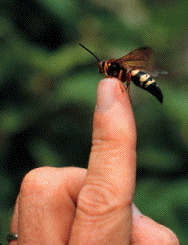Charles W. Holliday
 Professor, Animal Physiology
Professor, Animal Physiology
(hollidac@lafayette.edu) e-mail
(610) 330-5461 voice
(610) 330-5705 FAX
Personal homepage
The current area of study in my lab is the biology, systematics and physiology of cicada-killer wasps. Female cicada-killers determine the sex of each egg they lay before they lay it on a paralyzed cicada and we are interested in learning the basis for the maternal male/female decision. To this end we have studied the natural history of the local population for several summers and are now trying to develop a protocol for rearing the wasps in the lab. If we are successful, we will be able to study the factors influencing the female wasp’s decision to lay male or female eggs. We are also studying the factors which cause a female wasp to chose one male over others with which to mate. I am also doing field studies on cicada killer populations in Arizona, Florida, Illinois and Texas, as well as here in Easton. At present these studies are limited to the summer season, when the wasps are available.
Since 1982 student research in my lab has been focused on the special problems of salt and water balance experienced by marine, estuarine and fresh water invertebrates, particularly crustaceans. Estuarine and freshwater crustaceans use special cells in their gills and kidneys to transport salt back into their blood to replace salts lost in the urine and by diffusion across the body surface. Although I am shifting my research interest to the project noted above, it is still possible to join me in investigating the relationships between the activity of the enzyme which powers the cellular sodium pump (sodium, potassium-ATPase) and inward ion transport in the gills and kidneys of crustaceans. In these investigations we use ion analyses (e.g.,flame photometry and electromagnetic end-point titrations), osmometry, enzyme assays and surgical manipulations to study salt and water balance.
In addition to laboratory projects, I occasionally sponsor students for library-based research projects in areas of interest to them.
Recent Research Projects and Publications:
- Size-specific provisioning by cicada killers, Sphecius speciosus, (Hymenoptera : Crabronidae) in north Florida (2010). J. Hastings, C. Holliday, A. Long, K. Jones and A. Grayson. Florida Entomologist 93(3):412-421 (2010).
- Cicada prey of New World cicada killers, Sphecius spp. (Hymenoptera: Crabronidae). Holliday, C.W., J. M. Hastings and J.R. Coelho. Entomological News 120(1): 1-17 (2009).
- Load carriage during foraging in two species of solitary wasps. Coelho, J. R., J.M. Hastings, C.W. Holliday and A. Mendell. Journal of Hymenoptera Research 17:57-63 (2008).
- Mating at high population density in a colonial territorial wasp, Sphecius speciosus Drury (Hymenoptera: Crabronidae). Hastings, J.M., J.R. Coelho, C.W. Holliday. Journal of the Kansas Entomological Society 81(3): 301-308 (2008).
- Body size relationship between cicada killers,Sphecius speciosus Drury (Hymenoptera : Crabronidae), and their prey: Does prey size determines wasp size? Hastings, J. M. , C.W. Holliday and J. R. Coelho. Florida Entomologist 91(4): 657-663 (2008).
- Sexual dimorphism of the femora, tibiae and hind tibial spurs in the eastern cicada killer, Sphecius speciosus Drury (Hymenoptera: Crabronidae). J.R. Coelho, J.M. Hastings, G. Flure and K. Barnes. Entomological News, 119(1): 11-18 (2008).
- DNA barcooding of New World cicada killers. J.M. Hastings, P.J. Schultheis, M.K. Whitson, J.R. Coelho and A. Mendell. Zootaxa 1713: 27-38 (2008).
- The effect of hind-tibial spurs on digging rate in female eastern cicada killers: Effects of digging rate on fitness estimates. J. Coelho, C. Holliday, Ecological Entomology 33: 403-407 (2008).
- Thermoregulation in male western cicada killers (Sphecius grandis Say) in the Chihuahuan desert. Coelho, J.R., C.W. Holliday, J M. Hastings, E. Maty, M Swigart, A. Mendell. Journal of Thermal Biology 32(5): 270-275 (2007).
- An improved key to the New World species of Sphecius (Dahlbom 1843) (Hymenoptera : Sphecidae). C. Holliday, J. Coelho. Annals of the Entomological Society of America 99(5): 793-798 (2006).
- The biology of the horse-guard wasp, Stictia carolina: a review of the literature. James Carrroll (’06).
- Effects of size and flight performance on intermale competition in the cicada-killer, Sphecius speciosus Drury (Hymenoptera: Sphecidae). J. Coelho, C. Holliday. J. Insect Behavior 14: 345-351 (2001).
- Factors affecting mate choice by female cicada-killer wasps, with Amanda T. Parton (’98), EXCEL Scholar.
- Changes in hemolymph osmolality and gill Na+ K+ -ATPase activity in the land hermit crab Coenobita clypeatus in response to salinity variations. An honors thesis presented to the faculty of the Dept. of Biology, May 5, 2006, by Joseph Oliver, who graduated summa cum laude with Honors in Biology and earned his M.D. from The University of Medicine and Dentistry of New Jersey.
- Gill Na, K-ATPase in the intertidal crab, Hemigrapsus nudus,with Amanda T. Parton (’98).
 Representative Publications with Students:
Representative Publications with Students:
- McLaughlin, R. (’92), N. Firooznia (’94) and C.W. Holliday (1996). Branchial Na,K-ATPase activity and osmotic and ionic regulation in the Thai crab Pseudosesarma moeschi. Journal of the Pennsylvania Academy of Science 70: 46-52.
- Corotto, F.S. (’86) and C.W. Holliday (1996). Branchial Na,K-ATPase and osmoregulation in the purple shore crab Hemigrapsus nudus (Dana). Comparative Biochemistry and Physiology 113A: 361-368.
- Levetter, K.J.(’94), Majumdar, A.K.(’95), and C.W. Holliday (1994). An observational study of the cicada-killer wasp Sphecius speciosus. Proceedings of the Eighth National Conference on Undergraduate Research 8: 933-937. Student Poster Presentation.
- Salt, G.L. (’92) and C.W. Holliday (1992). Ecology of the cicada-killer wasp Sphecius speciosus. Proceedings of the Sixth National Conference on Undergraduate Research 6: 1399-1404. Student Poster Presentation.